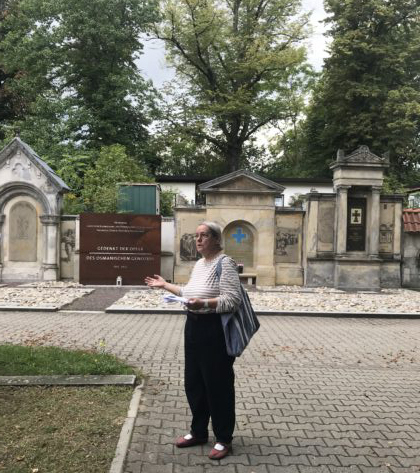
Dr. Tessa Hoffman
Virtual Genocide Memorial Launched
by Muriel Mirak-Weissbach
AUGUST 18, 2022 – On August 10, after three years of hard work, Dr. Tessa Hofmann announced the launch of a new website, the Virtual Genocide Memorial (https://virtual-genocide-memorial.de). Hofmann is a pioneer of genocide research in Germany, one of the first scholars here to publish scientific research on the Armenian genocide. Active for many years at the Free University of Berlin, she has produced scores of books and articles on the fate of the Christian communities in the Ottoman Empire, not only the Armenians, but also the Greeks and Syrian Orthodox (Aramaeans). An early campaigner for Germany to officially recognize the genocide, as chairwoman of the human rights organization, “Working Group Recognition – Against Genocide, for International Understanding” (AGA), she also co-founded the Association for the Promotion of an Ecumenical Memorial to Genocide Victims in The Ottoman Empire (FÖGG).
The FÖGG is dedicated to commemorating genocides, educating, learning from the past and preventing their repetition in the future. It established a unique memorial in Berlin between 2012 and 2018. (See https://mirrorspectator.com/2018/03/01/ecumenical-altars-remembrance-berlin ) The memorial, as the name indicates, is ecumenical, representing Armenians, Greeks and Syriacs of various denominations. It honors the memory of those more than 3 million Christians who were deported, sent into forced labor and massacred, and preserves the tradition of their cultural heritage.
As explained on its home page, the new website, “complements this analogue genocide memorial in Berlin-Charlottenburg. It reconstructs the life of Christian communities before their annihilation, paying particular tribute to their contribution to the culture and economy of the Ottoman Empire. At the same time we want to document the annihilation of these communities, both in textual, photo or video documents. This focus on genocide studies, as well as our inclusive ecumenical approach, distinguishes us from similar projects of textual and photographic reconstruction on national or regional levels.”
Sixteen Ottoman Provinces
The documents on the website are arranged according to the administrative organization of the Ottoman Empire at the beginning of the 20th century. As established through the “Provincial Law (Vilâyet Nizamnâmesi) of 1864, each province (vilayet) was divided into judicial districts (sancak), these in turn into counties (kaza), the counties into boroughs (nahiye) and these into local communities (kariye). The local communities were headed by a mukhtar, the municipalities by a mayor (müdir), the cantons by a kaymakam, the judicial districts by a mutassarıf and the provinces by a governor (vali).” Visitors to the website who open the menu will be able to choose from among 16 Ottoman provinces. If one looks under Regions, The Six Provinces (Vilâyet-ı Sitte), for example, and clicks there, one will arrive at a list including Bitlis, Diyarbekir, Mamuret ül-Aziz, Sivas and Erzurum. By choosing Diyarbekir, one comes to a page showing a photo of a commemorative plate placed in the ground at the Ecumenical Memorial in Berlin. There follow maps, and texts explaining the name, summarizing the history and administrative divisions, characterizing the population as whole and the Armenian population. Here one reads about the trades and professions of the Armenians, before moving on to the Greek and Syriac populations. The destruction of the cities and their inhabitants, the monuments etc. are detailed and richly illustrated.
The site visitor learns about the locations and the fate of their people, through selected texts from historical studies, contemporary accounts, memoirs, and many, many photographs.
Appeal for Support
Hofmann, the research editor who organized the website virtually by herself, calls for support and collaboration: “Such a project cannot be carried out by a few individuals,” she writes, “but depends on the support of colleagues and the related Armenian, Greek and Syriac communities concerned. We therefore ask for your support: Please provide suitable texts (preferably in English or with English translation) or photo documents for the Virtual Memorial, from private property or from your work and research context. Videos of the present state of the former Armenian. Syriac or Greek buildings and settlements are also welcome, as are videos and photos that give an impression of the landscape in which Armenians, Aramaeans and Greeks lived a hundred years ago.”